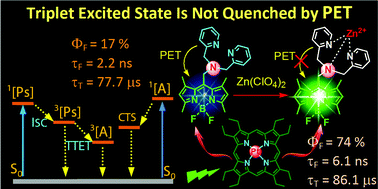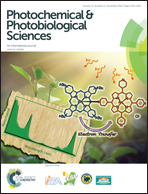The unquenched triplet excited state of the fluorescent OFF/ON Bodipy-derived molecular probe based on photo-induced electron transfer†
Abstract
Fluorescent molecular probes based on photo-induced electron transfer (PET) are well-known for which fluorescence is efficiently tuned OFF/ON by a PET process. Now we demonstrate that the triplet excited state of the probes is unable to be quenched by PET, which is in stark contrast to the singlet excited state (fluorescence). This conclusion was proved by the preparation of a fluorescent molecular probe BDP-DPA, which shows enhanced fluorescence upon addition of a Zn(II) salt. With fluorescence spectroscopy, nanosecond transient absorption spectroscopy and electrochemical studies, we found that the triplet excited state of BDP-DPA was not quenched by any PET process, although the singlet excited state (fluorescence) of BDP-DPA was quenched. The results are useful for the study of the triplet excited states of organic chromophores and for designing external stimuli-activatable triplet photosensitizers for triplet–triplet annihilation upconversion and photodynamic therapy.



 Please wait while we load your content...
Please wait while we load your content...